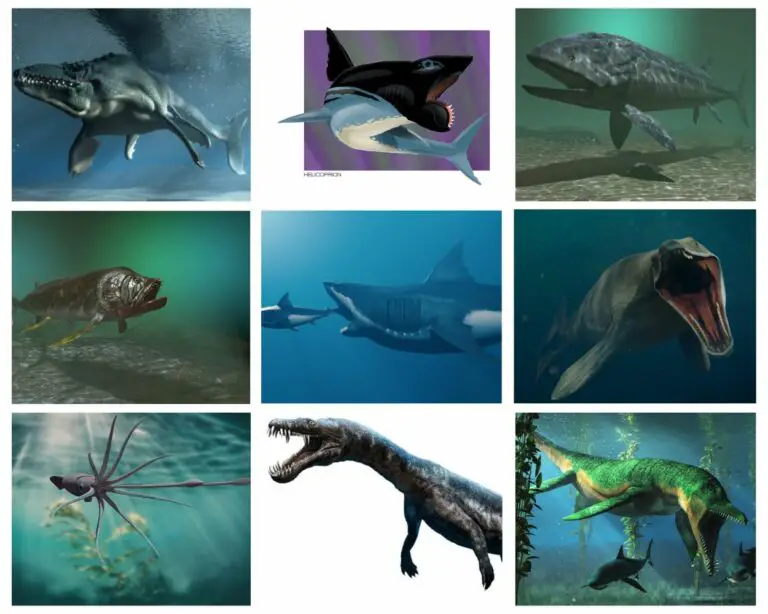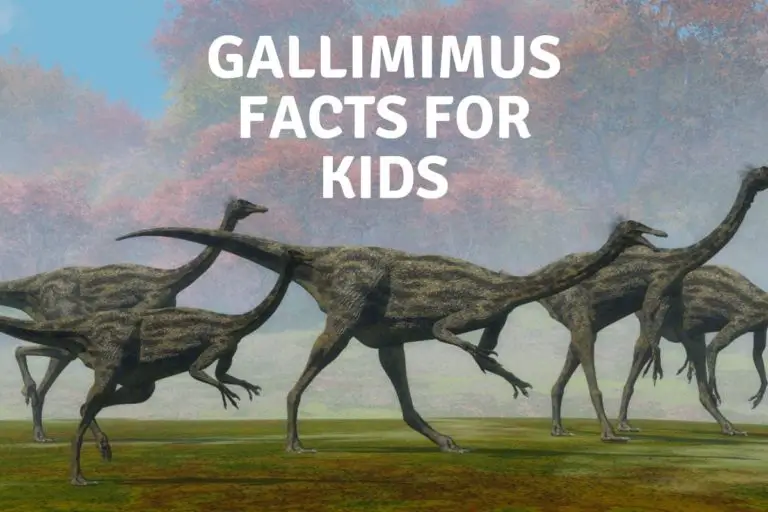How Big Was Megalodon?
Megalodon, the largest shark to have ever lived, by far, was an frankly awe-inspiring creature that swam in Earth’s oceans during the Miocene and Pliocene epochs, approximately 23 to 3.6 million years ago. Its massive size and powerful bite made it the ultimate apex predator of its and pretty much any other time. In this article, We take a deep (HA!) look into the size of Megalodon and how it compares to other marine creatures, both ancient and modern.
Megalodon was an enormous shark, with the most recent estimates suggesting it could measure up to 20.3 meters (67 feet) in length and possibly weighing between 50,000 to 100,000 kg (110,000 to 220,000 lbs). Although on average it would have been smaller at around 11 metres (34 feet) and 30-40000 lbs.
To help give you a better idea of just how big a megalodon actually was we will break down the size of Megalodon into length and weight and how and why it reached these sizes. We also have a just for fun section where we compare it to other more common items you may be more familiar with.
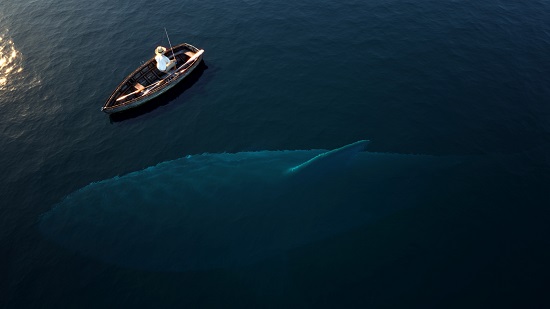
What Was Megalodon?
Megalodon, whose name ( very apt) means “big or large tooth,” was a giant prehistoric shark that lived during the Miocene and Pliocene epochs, approximately 23 to 3.6 million years ago. It was a member of the extinct Otodontidae family, which included other massive sharks like the lesser-known Carcharocles angustidens and Carcharocles chubutensis.
Despite what some sensationalist documentaries will tell you megalodon are not alive today, so worry not not if you are heading to the beach, or at least don’t worry that a 40 foot long shark is waiting for you! its not!
Megalodon had a massive body, powerful jaws, and enormous serrated teeth, some of which measured up to 18 centimeters (7 inches) in length. although more likely to be 5 or so inches. It was a highly efficient swimmer, capable of capturing and consuming a wide variety of marine life, with a particular preference for large marine mammals such as whales. Which is why it grew to such large sizes to be able to take on prey of this size.
if you are looking for cool dinosaur stuff like movies, masks, fossils, books toys, models and so much more we have put in the ground work for you and have collected some of our favorites here for you to browse over.
How Big Was Megalodon?
As mentioned earlier, Megalodon was the largest shark ever, with an estimated maximum length of up to 20.3 meters (67 feet) and an estimated weight range of 50,000 to 100,000 kg (110,000 to 220,000 lbs). While there is some debate over the exact size of Megalodon, most researchers agree that it was the largest shark species ever to exist.
The size and weight estimates can vary depending on the shark species it is compared to with the most common being great White shark, Mako shark and Sand Tiger Shark.
On average it is thought that a megalodon would have been around 34 feet (11 metres) or so with a weight of around 20,000 kg (44,000 lbs) which is still pretty much double a large great white shark today.
Although we look at the megalodon size comparison with other both prehistoric and modern animals later in the article we thought it would be fun to give you an idea of these massive size of megalodon by comparing it to some more common household items first. You can check these out in the length and weight sections below.
We take an average Megalodon of about 40 feet in length and weighing around 77,000 lbs to give a ore relatable size comparison.
Length of Megalodon
The length of Megalodon, estimated at up to 18 meters (59 feet), made it an incredibly large predator, although not the longest of all time its power and that incredible set of 200 plus teeth likely made it the most successful at least for a long while.
The size of Megalodon is known from the fossil evidence discovered so far, which includes teeth and vertebrae. We discuss below why there are few other fossils of Megalodon and sharks.
However even with just teeth and some vertebrae, by studying these, scientists can reconstruct the size of Megalodon and better understand its anatomy again the size will vary depending on the type of shark they base the model off.
This large size of Megalodon certainly provided several advantages in its marine environment. For example, a larger body would have enabled it to move more efficiently through the water, allowing it to cover greater distances in search of prey. Its large size would have offered protection against potential predators or rivals and of course when eating animals as large as baleen whales size really does matter.
Megalodon length compared to Real life objects:
- Megalodon’s length (40 feet) is roughly equivalent to the length of two standard cars (each about 15-20 feet long) parked end-to-end.
- The length of a Megalodon is approximately equal to the height of a four-story building.
- Megalodon’s length is equivalent to about 10 adult male bicycles lined up end-to-end (each with a length of around 4 feet).
- Megalodon’s length (40 feet) is about equal to the length of a bowling lane (which is typically around 41-42 feet long).
- The length of a Megalodon is approximately equal to the length of eight queen-size beds lined up end-to-end (each with a length of around 5 feet).
Weight of Megalodon
The weight of Megalodon is estimated to be between 50,000 to 100,000 kg (110,000 to 220,000 lbs). Although more averages would have been around 30-40,000 lbs. This massive weight helped produce power and strength as a marine predator.
With such a heavy body, Megalodon would have been able to take on large and powerful prey items, including whales, seals, and other marine mammals. Like on land with large predators and dinosaurs like sauropods there was an “arms race” between whales and their predators on who could get to be the biggest size.
Megalodon weight compared to Real life objects:
- Megalodon’s weight (77,000 lbs) is equivalent to the weight of approximately 2,200 average adult male golden retrievers (each weighing around 35 lbs).
- The weight of a Megalodon is roughly equal to the combined weight of 1,925 standard-sized refrigerators (each weighing around 40 lbs).
- Megalodon’s weight (77,000 lbs) is equivalent to the weight of approximately 11 African elephants (each weighing about 7,000 lbs).
- The weight of a Megalodon is roughly equal to the combined weight of about 308,000 cans of soda (each weighing around 0.25 lbs).
- Megalodon’s weight is approximately equal to the weight of 2,564,706 U.S. pennies (each weighing about 2.5 grams or 0.0055 lbs).
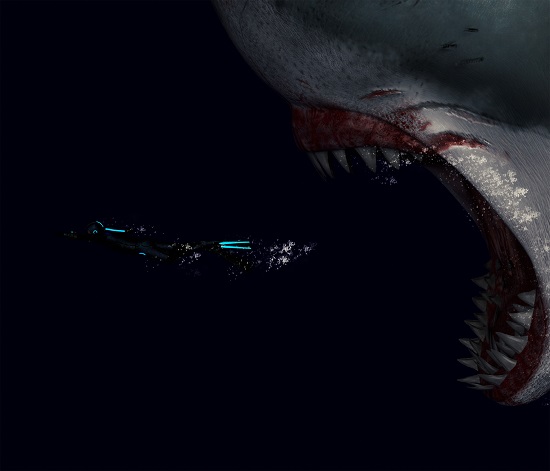
Comparison with Other Sharks and Marine Creatures
To better understand the size of Megalodon, it’s helpful to compare it with other sharks and marine creatures, both ancient and modern. As we compare with modern day marine animals in the table below The following table shows a size comparison between Megalodon and other prehistoric animals ( all of them known for their size)
Table 1: Size Comparison between Megalodon and other marine creatures.
| Species | Average Length (Feet and metres) | Large Length (Feet and metres) | Average Weight (lbs and Kg) | Large Weight (lbs and Kg) |
|---|---|---|---|---|
| Megalodon | 30-40 | 50-60 | 66,000-88,000 | 110,000-132,000 |
| Kronosaurus | 30-34 | 34 | 22,000-28,000 | 28,000 |
| Mosasaurus | 45-50 | 59 | 15,000-20,000 | 30,000 |
| Livyatan | 44-57 | 57 | 40,000-50,000 | 50,000 |
| Dunkleosteus | 20-30 | 30 | 3,000-8,000 | 8,000 |
| Liopleurodon | 20-23 | 23 | 3,300-3,850 | 3,850 |
| Leedsichthys | 50-55 | 55 | 40,000-60,000 | 60,000 |
| Shastasaurus | 65-69 | 69 | 75,000-85,000 | 178,574 |
The table shows that Megalodon was larger than most marine reptiles that lived before it and comparable even to the prehistoric Sperm Whale Livyatan which lived at the same time.
Where Did Megalodon Live and With Which Other Marine Creatures?
Megalodon lived during the Miocene and Pliocene epochs, approximately 23 to 3.6 million years ago. Its fossils have been found on every continent except Antarctica, indicating that Megalodon had a widespread distribution in the world’s oceans.
Megalodon shared its environment with a diverse range of marine life, including whales, dolphins, seals, sea turtles, and other sharks. and as we mentioned above possibly even other great predators live Livyatan.
Towards the end of its time on Earth it may have also lived and competed with ancestors of great whites and early orcas which would have competed for similar prey.
How Do We Know the Size of Megalodon?
We cover this a lot in our How big are dinosaurs articles ( links below) As with other prehistoric creatures, scientists and paleontologists use various methods to estimate the size of sharks like Megalodon. The size of Megalodon is based on the analysis of fossil specimens that have been discovered and studied by paleontologists.
By examining the fossilized teeth and vertebrae, scientists can reconstruct the skeleton and estimate the overall size and dimensions of the shark. however just like when estimating the size of dinosaurs it can be difficult and a lot of comparison and computer modeling has to be undertaken.
There was even a VR experience from the movie the Meg where you could experience a megalodon live, well kinda you can check that out below.
Why Megalodon Size Estimates are more problematic
Estimating Megalodon’s size relies on methods such as comparisons with modern sharks, statistical models, and the study of fossilized teeth and vertebrae. As sharks have a cartilaginous skeleton, which decomposes more easily than bone, fossils are rare.
So scientists often use Megalodon’s teeth, which are a lot more likely to fossilize, to estimate its size by comparing them to the teeth of modern sharks and then scaling up to fit a megalodons size.
of course depending on which shark is used can affect, quite dramatically, the size of the estimate especially when it comes to weight with the body builds of the Great White, Sand Tiger and Mako Shark ( the three most common sharks used in comparison) all being very different.
Where to Buy Megalodon Teeth?
if you wanted to try to work out how big a megalodon shark is you can buy 9 or find but we have an article linked on how to do that) your own megalodon teeth and give it a go.
Megalodon teeth can be purchased from a variety of sources, such as fossil shops, online retailers, and even some museum gift shops. When purchasing a Megalodon tooth, it is essential to ensure that the specimen is authentic and ethically sourced.
Some reputable online retailers specialize in selling fossils, including Megalodon teeth, and can provide certificates of authenticity. It is also a good idea to research the seller’s reputation and read customer reviews to ensure that you are purchasing a genuine and high-quality Megalodon tooth.
Prices can vary greatly depending on the size, condition, and rarity of the tooth, so it is essential to do your research and shop around to find the best specimen for your collection.
How to work out the size of Megalodon from its teeth.
Now we have to preface this with a HUGE note. This is our way of working it out and it comes with warnings that we do it using back of a beermat type math’s! so we figure the following.
The large tooth ever found is about 7 inches ( just over)
The largest estimate ( outside of movies and novels — looking at you Steve Altern! ;P ) is about 67 feet
So if 7 inch teeth are the largest we can perhaps scale this down to the following
- 7 inch teeth equals a 60+ feet long Megalodon
- 6 inch teeth equals a 55+ feet long Megalodon
- 5 inch teeth equals a 40+ feet long Megalodon
- 4 inch teeth equals a 35+ feet long Megalodon
- 3 inch teeth equals a 30 + feet long Megalodon
- 2 inch teeth equals a 20 foot long Megalodon
- 1 inch teeth equals a 10 foot long Megalodon
How Big and Long were megalodon teeth?
the most commonly found teeth are about 3 inches long and as 30+ long is the average length estimate of a Megalodon this fits. however, it is just a guess and of course where the tooth is in the mouth also plays a huge aspect as well.
The fossil guy website has a much more in depth ( and it has to be said better) formula for this.
we have a picture of the megalodon tooth that we own, it is about 5.5 inches long.
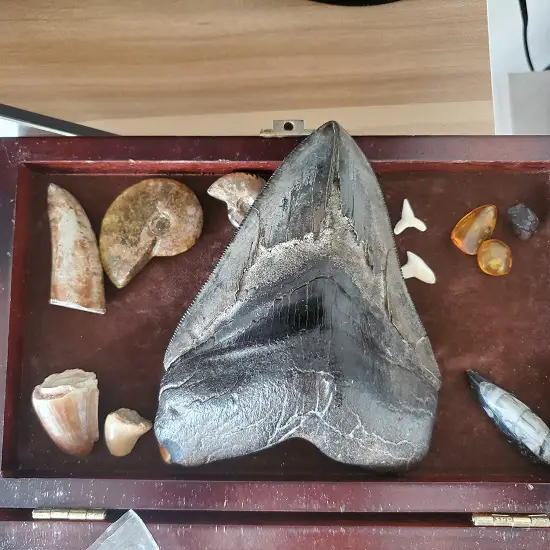
of course if you are lucky enough to live in an area that has megalodon fossils you can always go and try to find megalodon teeth yourselves. We have a guide here on how to do this
What Was the Range of Size of Megalodon:
Megalodon sharks exhibited a range of sizes, from the smaller, juvenile individuals to the massive, fully-grown adults. Current most recent estimates at the time of writing suggest the following.
- Juvenile Megalodons were estimated to be around 4-5 meters (13-16 feet) in length. As they reached adulthood, their size increased substantially,
- Average adult Megalodon measuring between 10 to 13meters (30-41 feet) in length.
- Some of the largest Megalodon specimens are believed to have reached up to 20 meters (65 feet) or more, making them some of the most massive predatory fish to have ever existed and certainly some of the scariest.
Size Comparisons with Modern-Day Animals
To give you some idea of how large Megalodon actually was, we have compared it to some more common animals you can see alive today:
Table 2: Megalodon size comparison with modern-day marine animals.
| Species | Average Length (Feet and metres) | Large Length (Feet and metres) | Average Weight (lbs and Kg) | Large Weight (lbs and Kg) |
|---|---|---|---|---|
| Megalodon | 30-40 | 50-60 | 66,000-88,000 | 110,000-132,000 |
| Great White Shark | 15 | 20 | 1,500-2,500 | 4,000-5,000 |
| Tiger Shark | 10-12 | 16 | 850-1,400 | 2,000-2,500 |
| Whale Shark | 32 | 40 | 20,000-30,000 | 45,000-55,000 |
| Mako Shark | 10 | 12 | 1,200-1,500 | 1,800-2,000 |
| Basking Shark | 20-26 | 32 | 6,000-8,000 | 12,000-14,000 |
| Sperm Whale | 49 | 67 | 77,000-110,000 | 130,000-190,000 |
| Orca (Killer Whale) | 23 | 32 | 8,000-12,000 | 20,00 |
we actually have an article about megalodon Vs a blue whale in terms of size ( and a fight!) here on the site if you want to jump into that.

Megalodon FAQ
To keep the article length in check we have few brief answers to some popular megalodon questions if you found yourself here after watching one of the megalodon movies. Most of these have a longer article linked in if you want more information.
Extinction of Megalodon
Megalodon went extinct around 3.6 million years ago, and there are several theories as to why this happened. Some of the most common explanations include:
- Climate change: As the Earth’s climate changed, the oceans cooled, and the sea levels dropped. Megalodon, which was adapted to warm, shallow waters, may have struggled to adapt to these new conditions.
- Loss of prey: As the climate changed, the populations of Megalodon’s primary prey, such as whales and other large marine mammals, may have diminished or migrated to different areas. This could have led to a decline in the food supply for Megalodon, making it difficult for the species to survive.
- Competition: Other large marine predators, such as the ancestors of modern great white sharks and orcas, may have outcompeted Megalodon for food and resources.
- Reproduction: Megalodon’s large size and slow reproductive rate may have made it more vulnerable to population decline and extinction.
Megalodon’s Bite Force and Hunting Strategy:
Megalodon’s incredible bite force is estimated between 110,000 and 180,000 newtons, making it one of the most powerful predators to have existed. Its large jaws and rows of serrated teeth allowed it to take massive bites out of its prey, typically marine mammals like whales.
Megalodon was an ambush predator, using its speed and strength to surprise prey and deliver lethal bites to critical areas, such as the fins and tail, immobilizing the prey before delivering a fatal bite. you can read more about the megalodons incredible bite force here on the site. it was bigger than any other known animal.
Megalodon in Popular Culture:
Megalodon has captured the imagination of audiences through movies like “The Meg” and “The Black Demon,” as well as TV shows and literature. These portrayals often exaggerate the shark’s size and ferocity, although in the novels it is only slightly larger than the current estimate with Angel the megalodon in the Steve Alten Series of books being 70+ feet.
While entertaining, it’s essential to separate fact from fiction when studying Megalodon’s true size, behavior and nature. Even with giant movie monsters they always seem to make them bigger!
We have a whole article on the current and upcoming Megalodon movies here on the site if you wanted some weekend viewing, though these movies vary in quality greatly!! There are plenty of Meg movies worth a watch though, especially if the main story features a huge shark!.
Where can you see Megalodon today.
While Megalodon has been extinct for a couplie of million years, it is still possible to visit museums and see fossils, mainly of shark teeth Megalodon and other sharks and occisionally megalodon fossil vertebrae as well
. Although some natural history and marine museum do have full jaw reconstructions and even full shark models as well. We saw one in Helsinki natural history museum quite randomly once.
Did Any Sea Animal Have Bigger Teeth than a Megalodon
Well actually there was at least one animal than had longer and bigger teeth than a megalodon, and it lived at the same time, and ate the same prey. The Livyatan, a giant Sperm whale, had teeth that could be 14 inches long. if you are wondering what would happen if a Livyatan and a megalodon met, so were we and wrote an article here about that.
Conclusion,
Megalodon was an enormous and powerful predator that dominated the oceans at least 3 or so million years ago. Its massive size, coupled with its powerful bite force and formidable teeth, made it a fearsome and unparalleled marine predator.
At a maximum estimate size of around 67 feet and possible 100-200,000 lbs. it was truly massive. Even at its 30-40 feet estimated average size it was still the largest predatory shark ever to have existed, and if they grew bigger …
We have a series of articles on How Big Dinosaurs were, including sauropods and carnivores, and you can follow the links below to check out the size of other popular dinosaurs. We are expanding this section on a regular basis.
References
- https://www.nhm.ac.uk/discover/megalodon–the-truth-about-the-largest-shark-that-ever-lived.html
- https://en.wikipedia.org/wiki/The_Meg
- https://en.wikipedia.org/wiki/Megalodon
- https://www.popularmechanics.com/science/animals/a33918172/megalodon-official-size/
- https://www.bristolpost.co.uk/news/bristol-news/total-size-giant-meg-shark-4481915
Hi, I am Roy Ford a General Studies and English Teacher who has taught all over the world. What started as a fossil collection became a great way to teach, motivate and inspire students of all ages and all over the world about dinosaurs and from that and children’s love of dinosaurs came the site dinosaur facts for kids, a resource for all ages.



